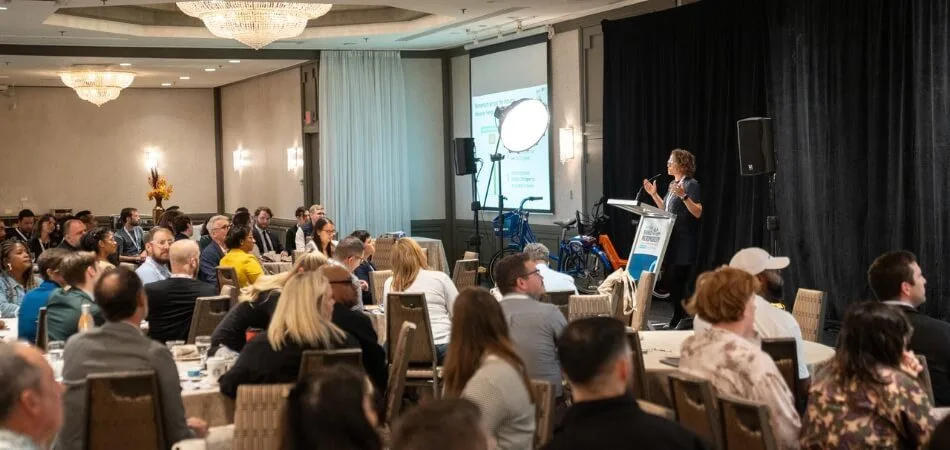Conferences are full of energy, ideas, and connections, but once they end, those valuable insights can easily get lost in busy schedules. That’s why capturing the highlights in a recap is so important. If you’re wondering how do you write a conference recap, the process is easier than it seems when you follow the right steps.
Start by organizing your notes and choosing the most important sessions, speakers, or takeaways to highlight. Use clear headings, short paragraphs, and simple language so readers can quickly scan the main points of your recap. Add quotes, photos, or personal observations to make it engaging and give your audience useful insights they can apply.
If you want to create recaps that stand out and truly reflect the value of your event, this guide is for you. Keep reading to discover practical tips, easy formatting techniques, and proven strategies to write a conference recap that is both professional and enjoyable to read.
Step-by-Step: How Do You Write a Conference Recap?
Writing a conference recap isn’t just about noting down what happened; it’s about turning your experience into a clear, engaging story that others can learn from. Whether your goal is to share highlights with colleagues, update stakeholders, or publish a blog recap, following a step-by-step process keeps your writing structured and impactful.
Step 1: Take Notes & Collect Assets
Don’t rely on memory alone. Capture key points, speaker quotes, and session takeaways while the event is still fresh. Snap a few photos, gather presentation slides, and jot down action items. These assets will give your recap depth and credibility.
Step 2: Define Your Audience
Ask yourself, who is this recap for? If it’s for your internal team, focus on decisions and action items. If it’s for a public blog, emphasize stories, speaker insights, and highlights so the recap stays useful when you prepare for upcoming conferences as well.
Step 3: Start With Gratitude
Begin your recap on a positive note by thanking attendees, speakers, or sponsors. Acknowledging contributions creates a warm, collaborative tone and encourages readers to stay engaged with your summary.
Step 4: Organize Key Topics & Takeaways
Summarize the big themes of the conference in a structured way. Use short subheadings or bullets so readers can quickly scan and identify the sessions or ideas most relevant to them.
Step 5: Highlight Action Items
Clarity drives accountability. Clearly list the next steps, responsibilities, and deadlines discussed. This transforms your recap from a summary into a working document that guides future progress.
Step 6: Add Visuals, Quotes & Metrics
Make your recap more engaging by including:
- Short speaker quotes that capture insights
- Visuals like charts or attendee snapshots
- Key numbers (attendance, survey results, social mentions)
This brings your recap to life and makes it more memorable.
Step 7: Attach Relevant Documents & Resources
Include links to slide decks, videos, or reference materials. Giving readers access to resources extends the value of your recap and helps them dive deeper into topics of interest.
Step 8: Confirm Next Steps & Future Dates
If another event or meeting is coming up, close your recap with a reminder. Adding dates for the next discussion keeps everyone aligned and ready.
Step 9: Proofread & Polish
Before sending or publishing, review your recap for accuracy, grammar, and flow. A clean, well-edited recap reflects professionalism and ensures your audience focuses on the content, not the errors.
By following these steps, you’ll have all the elements needed for a clear and impactful recap. But to make the process even easier, we’ve created ready-to-use templates that you can download and adapt right away.
Template A: Public Blog/Event Recap
[Headline/Title]
“Highlights from [Conference Name] 2025”[Introduction]
One or two sentences about the event (location, theme, why it mattered). Mention how many people attended or the focus of the sessions.[Highlight 1: Keynote or Major Session]
- Speaker name + main takeaway
- Quote (if available)
- Optional photo or visual placeholder
[Highlight 2: Notable Discussion/Panel]
- What was discussed
- Why it was valuable or unique
- Key statistic or insight
[Highlight 3: Networking/Workshops/Other Activities]
- Describe the experience briefly
- Share one or two participant perspectives
[Key Takeaways Section]
- Bullet list of 3–5 actionable insights
[Next Steps/Call-to-Action]
Invite readers to download slides, watch recordings, or register for the next event.
Template B: Internal One-pager Recap
Event Snapshot
- Event: [Conference Name]
- Date/Location: [Insert]
- Attendees: [Number/Teams present]
- Purpose: [One-line objective]
Top 5 Takeaways
- [Key insight 1]
- [Key insight 2]
- [Key insight 3]
- [Key insight 4]
- [Key insight 5]
Decisions Made
- [Decision 1 with owner]
- [Decision 2 with owner]
Action Items
- [Action item] → Assigned to [Name/Team], deadline [date]
- [Action item] → Assigned to [Name/Team], deadline [date]
Supporting Documents
- [Link to slides]
- [Link to handouts]
- [Link to survey results]
Next Meeting/Follow-Up
- Date: [Insert date]
- Agenda: [Topics to discuss]
This format also works well as a conference report example, since it captures the most important outcomes and responsibilities in a structured, easy-to-share way.
What to Measure & Show in Your Recap?
Adding real numbers and results makes any recap more valuable than words alone. Tracking the right details helps your audience see the true impact of the event and why it mattered. Let’s look at a few simple metrics that can make your conference highlights stronger and more trustworthy.
Attendance vs. Registrations
Show how many people actually attended compared to how many signed up. This quick snapshot tells readers if the event had strong engagement or if attendance dropped off. Even a simple percentage makes a big difference.
NPS or Feedback Scores
Feedback surveys give you a real sense of how people felt about the event. Use short surveys to calculate a satisfaction score or Net Promoter Score (NPS). Sharing the average score and a few comments adds credibility to your recap.
Social Reach & Engagement
Events don’t just happen inside the venue anymore. Mention how many people shared posts, tagged the event, or used your hashtag. Highlighting these numbers adds depth to your event recap and shows how far your conference conversations reached online.
Leads or Demos Booked
If your event had booths or product demos, note how many leads were collected or demos scheduled. This makes it easy for stakeholders to see the business value of participating.
Media Mentions
Press coverage, blog articles, or podcast features should be included. Even a handful of mentions helps prove the event’s influence beyond the attendees. This is also a useful point of reference if you’re writing a conference report alongside your recap, since it adds measurable proof of the event’s reach.
How to Share Your Conference Recap?
Writing a recap is only half the job. The real value comes when you share it with the right people in the right way. A well-written recap deserves to be seen, whether it’s by your team, event sponsors, or the broader community. Let’s look at the best ways to get your recap out there.
Publish on Your Website or Blog
Post your recap as a blog article with images, quotes, and highlights. It becomes a shareable resource that shows off your event’s impact while also boosting your site’s content library.
Send It by Email
Email is still the most direct way to reach attendees and stakeholders. Include a short thank-you message, link to the recap, and attach slides or a PDF. For absentees, it’s a simple way to keep them updated.
Share on Social Media
Turn highlights into bite-sized posts for LinkedIn, X (Twitter), and Instagram. Add a few visuals, speaker quotes, or stats. Social platforms are where you’ll reach people who couldn’t attend but still care about the topic.
Create a Visual Version
Not everyone wants to read long texts. Consider turning your recap into a short video, an infographic, or a carousel post. Visual summaries are easy to consume and more likely to be shared.
Use It for Sales or Partnerships
If the event had sponsors or business goals, package your recap as a one-pager. Share it with potential partners or clients to show the value your events create. It works as proof of impact and credibility.
Sample Email for Attendees
Subject: Thank you for joining us – Here’s your event recap
Hi [First Name],We loved having you at [Conference Name]. To help you revisit the key moments, we’ve put together a recap with highlights, insights, and resources.
[Read the Full Recap]
Thanks again for being part of it. We look forward to seeing you at our next event.
Best regards,
[Your Team]
Sharing your recap widely ensures that the insights don’t fade away after the event. Whether you send it by email, post it online, or turn it into visuals, the goal is the same: keep the conversation going and make the event’s impact last longer.
Tips to Avoid Mistakes While Writing a Conference Recap
It’s easy to miss small details when you’re trying to wrap up a big event, but even little mistakes can weaken your recap. The good news is, avoiding the most common slip-ups doesn’t take much effort if you know where to look. Keep these points in mind to make your recap both professional and enjoyable to read.
- Keep the Structure Clear: A recap should flow naturally so anyone can follow along. Use headings, short paragraphs, or bullet points. A clean layout helps readers quickly pick out the most important details.
- Double-check Facts: Make sure names, titles, and numbers are accurate. Getting these wrong can confuse readers and lower trust in your recap. Taking a few minutes to verify saves trouble later.
- Avoid Jargon: Not everyone knows technical or industry-heavy terms. Stick to plain language so every reader can easily understand the main points without having to search for meanings.
- Be Concise But Complete: Include all the major highlights, but don’t overload your recap with extra filler. The best recaps balance being informative with being easy to scan.
- Assign Owners for Action Items: Whenever you mention next steps, add who is responsible. This makes the recap practical instead of just informational and ensures tasks don’t get lost.
- Proofread Carefully: Typos or awkward sentences can distract readers. Take the time to read your recap aloud or have someone else glance at it. Small edits can make a big difference.
- Publishing Too Late: If you wait too long, the details lose their impact. Aim to send or post your recap within 24-48 hours while the event is still fresh.
- Forgetting Visuals: All-text recaps often feel dull. Adding photos, charts, or even a simple graphic makes your recap more engaging and memorable. A short recap session with your team can also help confirm which visuals or details should be included.
By avoiding these simple mistakes, you’ll turn your recap into something people actually use instead of just skimming over it. A strong recap builds clarity, saves time, and keeps everyone aligned on what happens next.
Why Should You Write a Conference Recap?
Attending a conference is exciting, but the real impact comes when you share what you learned with others. A recap does more than summarize the event; it captures the value and makes sure the insights don’t fade away after the last session ends. Here’s why taking the time to write a conference recap is worth it.
Keeps Everyone on the Same Page
Not every attendee can be present in every session, and many people miss events entirely. A recap helps fill those gaps by giving both attendees and absentees a clear picture of what was covered. This ensures no one feels left behind or uninformed.
Provides Accountability
One of the most practical benefits of a recap is accountability. When you write down the next steps, owners, and deadlines, it becomes much harder for tasks to be forgotten. This clarity keeps momentum going and helps turn discussions into real progress.
Improves Information Retention
Details fade fast after an event. A recap acts as a reliable memory tool that people can revisit whenever needed. It turns fleeting discussions into a lasting resource, helping everyone recall the main ideas long after the conference is over.
Supports Better Planning
Conference recaps become a record you can look back on when preparing for future events. They highlight what worked well, what fell short, and what should change next time. This reflection makes planning more efficient and helps avoid repeating past mistakes.
Strengthens Communication
Sharing a recap with colleagues, stakeholders, or sponsors is a professional way to show that you value their involvement. It communicates not only what happened but also how the event connects to larger goals. This strengthens relationships and keeps people engaged.
Encourages Continuous Improvement
Over time, reviewing recaps can reveal patterns, recurring issues, successful strategies, or gaps that need attention. It’s also an opportunity for requesting conference feedback professionally, which ensures organizers gather honest insights to improve future events. This ongoing reflection helps both individuals and teams get better at organizing, attending, and benefiting from conferences.
Writing a recap isn’t about ticking a box; it’s about making the conference experience useful long after it ends. By capturing insights and sharing them widely, you create something people can trust, learn from, and use to take the next step.
Conference Recap vs. Post-event Report
It’s common to think a recap and a report are the same thing, but they serve very different purposes. One focuses on storytelling and highlights, while the other is about structure and accountability. Knowing the difference helps you decide which one to create. Here’s a simple comparison to make it clear.
Key Differences at a Glance
| Aspect | Conference Recap | Post-Event Report |
| Purpose | To share highlights, stories, and takeaways | To record minutes, tasks, and decisions |
| Audience | Public, attendees, stakeholders, social readers | Internal teams, managers, and organizers |
| Tone | Conversational, engaging storytelling style | Formal, structured, focused on accuracy |
| Content | Event overview, key sessions, quotes, photos | Detailed agenda, notes, and action items |
| Format | Blog posts, newsletters, social media recaps | Documents, spreadsheets, or internal PDFs |
| Goal | Share event highlights and inspire engagement | Track accountability and ensure follow-up |
Purpose
A recap focuses on telling the story of the event through highlights and key moments, while a report is designed to document detailed notes, outcomes, and responsibilities in a structured format.
Audience
Recaps are meant for attendees, stakeholders, or the public who want to revisit the highlights, whereas reports are intended for internal teams and managers who need full accuracy and accountability.
Tone
A recap uses a friendly and engaging style to keep readers interested, while a report relies on a formal and precise tone that prioritizes clarity and professionalism.
Content
Recaps highlight sessions, quotes, visuals, and memorable takeaways, but reports dig into complete agendas, discussions, and task assignments that leave nothing open to interpretation.
Format
Recaps usually appear as blog posts, newsletters, or social updates with visuals, while reports are prepared as formal documents, PDFs, or spreadsheets for easy reference within teams.
Goal
The main goal of recap is to spread excitement and share the value of the event with a wider audience, while the report ensures accountability and drives follow-up actions internally.
Together, the two serve different but complementary purposes: a recap connects people to the experience, while a report provides security, clarity, and responsibility. Choosing which to use or combining both depends on the outcome you want to achieve.
Frequently Asked Questions
Ending with a recap is helpful, but many people still wonder about practical details after learning the basics. These common questions will give you more clarity on writing, using, and sharing an effective conference recap.
How Long Should a Conference Recap Be?
A recap should be long enough to capture highlights but short enough to keep attention. Usually, 700-1,000 words is a good range. Add visuals and links for extra details instead of making it too long.
Can a Recap Be Written By Someone Who Didn’t Attend?
Yes, but it works best when they have access to notes, recordings, or feedback from attendees. Without these, important details might get missed. Whenever possible, someone who attended should take the lead in writing it.
Should a Conference Recap Include Photos?
Absolutely, adding photos makes a recap more engaging. They break up text and give readers a visual sense of the event. Just make sure to use high-quality, relevant images that add value to the story.
How Soon Should a Recap Be Shared Publicly?
The ideal time is within 24–48 hours of the event ending. That way, everything is still fresh for readers. Waiting too long makes the recap feel outdated and less impactful.
Can a Recap Double as Marketing Material?
Yes, a well-written recap can highlight your event’s success and attract future attendees. Sharing achievements, stats, and quotes shows credibility. Just keep the tone informative so it doesn’t feel like a sales pitch.
Is It Okay to Share a Recap on Multiple Platforms?
Definitely, but adapt it slightly for each channel. A blog version can be detailed, while LinkedIn or Instagram should focus on short highlights and visuals. Adjusting the style makes it more effective for different audiences.
Should Attendee Feedback Be Added in the Recap?
Yes, adding feedback or short quotes makes a recap feel authentic. It shows how people experienced the event in their own words. Just keep it brief and highlight comments that add real insight.
Do I Need to Mention Every Speaker or Session?
No, you only need to include the most important highlights. Mentioning every detail makes the recap overwhelming. Focus on sessions that had the strongest impact or those most relevant to your audience.
Concluding Words
A conference recap is more than just a collection of notes; it’s a way to extend the value of an event long after it’s over. It helps you preserve important discussions and share insights with a wider audience.
When you ask yourself how do you write a conference recap, the answer lies in keeping it clear, structured, and engaging. A good recap highlights the key takeaways, acknowledges contributions, and sets the stage for what comes next.
By turning your experience into a well-written recap, you create something useful and lasting. It keeps your audience informed, helps your team stay aligned, and ensures the lessons from the conference continue to make an impact.









